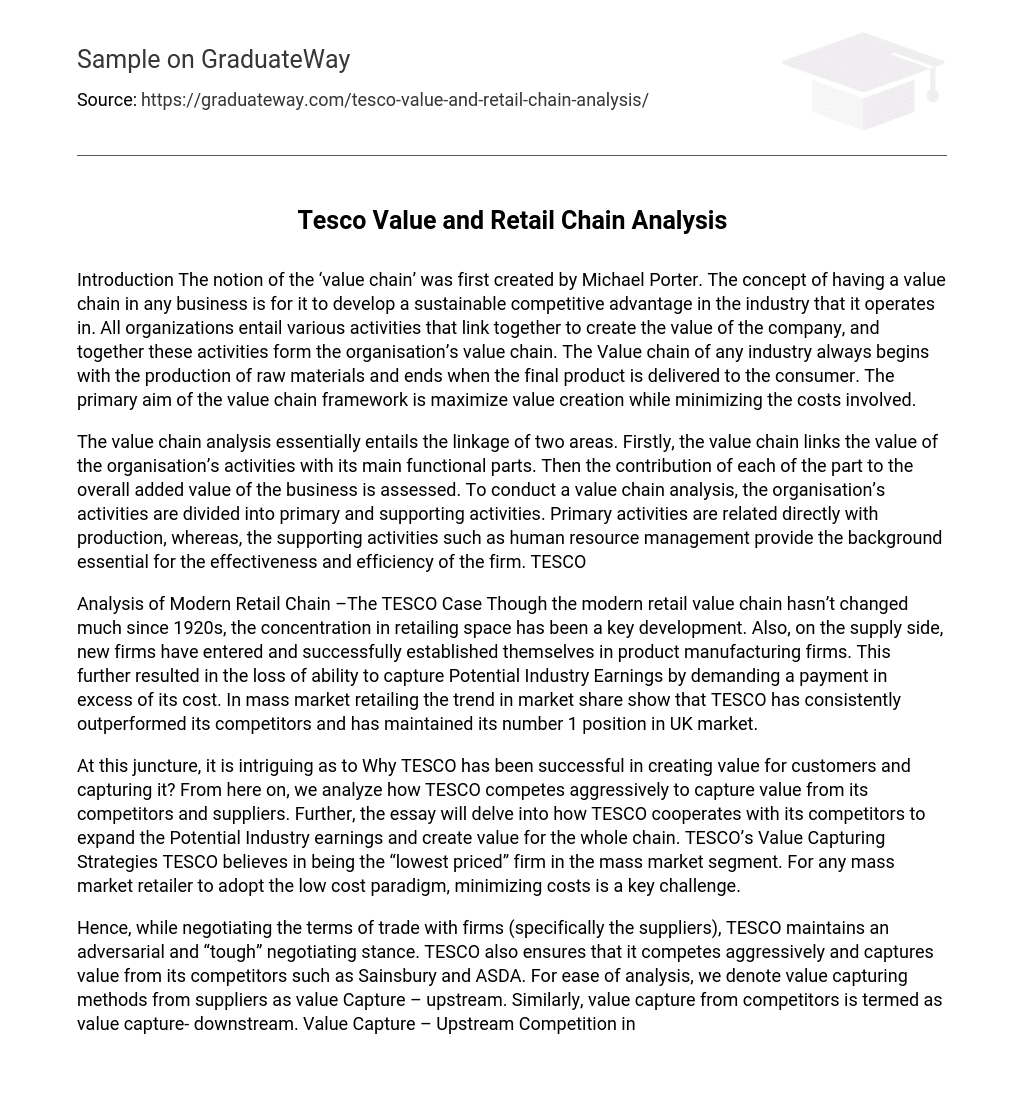The value chain, initially developed by Michael Porter, aids businesses in attaining a lasting competitive edge. It encompasses interconnected activities that contribute to the overall value of an organization. These activities span from raw material production to delivering the final product to consumers. The chief objective of the value chain framework is to optimize value creation while minimizing costs.
The value chain analysis is the process of connecting an organization’s activities with its main functional components and evaluating how each component contributes to the overall added value of the business. To conduct a value chain analysis, the organization categorizes its activities into primary and supporting activities. Primary activities are directly related to production, while supporting activities such as human resource management enhance the effectiveness and efficiency of the firm. TESCO
Analysis of the TESCO Case reveals that while the modern retail value chain has remained relatively unchanged since the 1920s, there has been a notable concentration in the retailing space. Additionally, new firms have emerged and established themselves in product manufacturing, leading to a decreased ability to demand excessive payment above cost and capture Potential Industry Earnings. TESCO, however, has consistently outperformed its competitors and remains the top player in the UK market for mass market retailing.
At this point, it is interesting to consider why TESCO has succeeded in creating and capturing value for customers. We will now examine how TESCO aggressively competes to capture value from competitors and suppliers, while also exploring how TESCO collaborates with competitors to expand potential industry earnings and create value for the entire chain. TESCO’s strategies for capturing value involve being the lowest priced firm in the mass market segment. However, for any mass market retailer to embrace the low cost approach, minimizing costs is a significant challenge.
TECSO adopts an adversarial and tough negotiating approach when discussing trade terms with suppliers. Additionally, TECSO actively competes with rivals like Sainsbury and ASDA to seize and maximize value. To simplify analysis, we refer to the methods of extracting value from suppliers as value capture – upstream. Similarly, we term the process of capturing value from competitors as value capture – downstream. Competing in any market segment diminishes the influence of buyers or suppliers within that segment.
TESCO recognizes the significance of supplier competition and therefore ensures that it has multiple suppliers for each product it offers. This strategy enables TESCO to engage in negotiations to obtain the most favorable prices for its products. By fostering competition among suppliers, TESCO effectively neutralizes their ability to dictate terms and influence trade agreements. This approach also mitigates the risk of being subject to the demands of a single dominant supplier. TESCO streamlines its sourcing process by consolidating its needs across all its UK stores before finalizing orders with the supplying companies.
TESCO benefits from purchasing in large quantities and consolidating its needs across UK stores. The significant volume of TESCO’s requirements makes it an appealing client for suppliers. Additionally, competition from other retailers also impacts the value that TESCO captures. As a mass market retailer with a focus on low prices, TESCO emphasizes gaining and protecting a sizable market share.
To maintain its market share, TESCO actively competes with other low-cost retailers. In recognition of the increasing growth in the retail industry, TESCO has strategically acquired land in prime locations within its key markets. This serves two purposes for TESCO. Firstly, it guarantees the availability of land for potential store expansion in the future. Secondly, it acts as a deterrent to competitors looking to expand, as they do not have access to desirable real estate in key areas. Ultimately, this enables TESCO to gain a competitive advantage over its rivals.
TESCO maintains its market share and encourages customer loyalty through various strategies. These include the introduction of loyalty cards, discount vouchers, cash back schemes, and free home delivery. In addition, TESCO has expanded its product offerings beyond traditional “need” based products to include home furnishing, banking, insurance, and mobile telephones. By entering new niches and offering unconventional products like banking, TESCO has successfully expanded its market share in these areas of retailing.
We have observed that TESCO utilizes adversarial measures to extract value from suppliers and competitors, but it also engages in cooperative efforts with them to amplify the overall value of the chain. This essay will examine TESCO’s strategies for value creation. TESCO pursues value creation by maintaining constant shares to increase profits for the entire segment. Additionally, TESCO collaborates with competitors, although these agreements may not be explicitly stated and could be considered tacit collusion.
TESCO, ASDA, and Sainsbury’s are renowned for being affordable retailers targeting the mass market. Their fierce rivalry has sparked price wars, causing a decline in overall value. In order to prevent a further decrease in Potential Industry Earnings, these retailers engage in an implicit agreement to refrain from competing on prices. They maintain their market shares in specific product categories and cooperate with each other, ultimately safeguarding the entire segment’s profitability. (Reference: Lynch, R. (2003), Corporate Strategy, 3rd ed., Prentice Hall Financial Times.)





